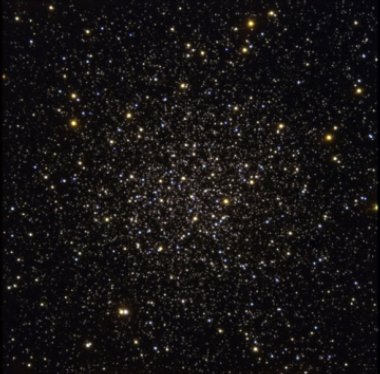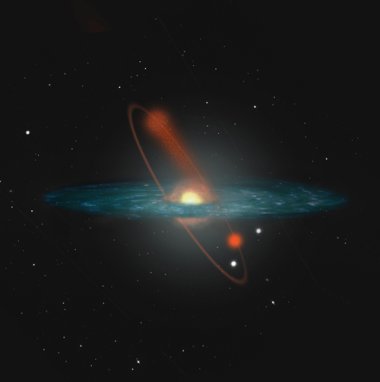A&A press release: Theft of a million stars in Globular Cluster Messier 12 (7 February 2006)
- Details
- Published on 07 February 2006
A&A press release
Released on February 7th, 2006
|
Theft of a million stars in Globular Cluster Messier 12 |
Based on the article “Why is the mass function of NGC 6218 flat?”, by G. De Marchi, L. Pulone, F. Paresce
(Published in Astronomy & Astrophysics.)
Messier 12 is one of about 200 globular clusters known in our Galaxy [2]. These are spherical aggregates made up of from 10,000 to more than a million stars. Globular clusters are a key tool for astronomers, because all the stars in a globular cluster share a common history. They were all born together, at the same time and place, and only differ from one another in their mass. By accurately measuring the brightness of the stars, astronomers can determine their relative sizes and stage of evolution precisely. Globular clusters are thus very helpful for testing theories of how stars evolve.
The team of Italian astronomers, led by G. De Marchi of the European Space Agency (Noordwijk, The Netherlands), observed Messier 12 using the FORS-1 camera on the Very Large Telescope (ESO, Chile) and measured the brightness and colours of more than 16,000 stars within this cluster. Located at a distance of 23,000 light years in the constellation Ophiuchus, Messier 12 got its name by being the 12th entry in the catalogue of stellar clusters compiled in 1774 by the French astronomer Charles Messier.

It has long been predicted that globular clusters lose stars while they orbit the Galaxy, due to tidal forces that can peel off the outer regions of the cluster, where the lower mass stars are most often located. This gravitational interaction is particularly strong when clusters move across the Galactic disc or venture close to the innermost and denser regions of the Milky Way, the so-called bulge. Due to repeated interactions with the bulge and the disc of the Galaxy, low-mass stars are ejected so that this process may eventually disrupt the cluster completely.
Several theoretical models predict the total lifetime of a globular cluster before disruption, depending on its orbital path. They did not anticipate that Messier 12 would suffer such strong tidal interactions and had predicted that it would therefore live unperturbed for several billion years. Following their new observational results, De Marchi and his colleagues believe that these models made wrong assumptions about the cluster’s orbit. By combining their own data with recent determinations of the orbit of Messier 12 in the Galaxy, it appears that the cluster comes much closer to the Galactic centre (about 2000 light years) than previously thought. With such an orbit, the total remaining lifetime of Messier 12 is predicted to be about 4.5 billion years. This is very short compared to the typical globular cluster’s lifetime.
The team calculated that Messier 12 has already lost about 80% of its original mass that is, about a million stars. This would place Messier 12 among what were originally the richest and most massive globular clusters in the Milky Way. Astronomers still cannot tell whether this haemorrhage of stars has been proceeding uniformly over time or whether it was much greater in the cluster’s earlier life. They are, however, convinced that the case of Messier 12 is by no means unique and that many more clusters must be dissolving.
The stars lost by Messier 12 have actually not completely disappeared. They still move around the Milky Way and may give rise to what astronomers call a tidal tail. Astronomers believe that a similar process occurred 10 billion years ago; a large number of small clusters would have been dissolved and formed the Milky Way halo. The halo of our Galaxy is a spherical pattern of very old stars that extend to large distances from the Galactic plane. Very little is presently known about the formation of this halo, because it has left no visible traces other than the current distribution of stars around the Galaxy. Not knowing where these stars originated makes it difficult for astronomers to learn about the process. But now scientists have hopes of discovering and studying many more clusters like Messier 12, since catching clusters while being disrupted should clarify the dynamics of the process that shaped the halo of the Milky Way.

[2] The globular gluster Messier 12 is also known as NGC 6218.
Why is the mass function of NGC 6218 flat?
by G. De Marchi, L. Pulone, F. Paresce
Published in Astronomy & Astrophysics (DOI number: 10.1051/00046361:20053775)
High-resolution pictures are available on the ESO web site.
Contact persons:
- Science:
Dr Guido De Marchi
European Space Agency
Noordwijk, Netherlands
Phone: +31 71 565 8332 - Email: gdemarchi @ esa.int
Dr Luigi Pulone
Observatory of Rome
Monte Porzio Catone, Italy
Phone: +39 06 9428 6445 - Email: pulone @ mporzio.astro.it
Dr Francesco Paresce
Italian National Institute of Astrophysics
Rome, Italy
Phone: +39 338 426 0196 - Email: fparesce @ inaf.it
- Press office:
Dr. Jennifer Martin
Journal Astronomy & Astrophysics
61, avenue de l'Observatoire
75014 Paris, France
Phone: +33 1 43 29 05 41 - Email: aanda.paris @ obspm.fr
© Astronomy & Astrophysics 2006


